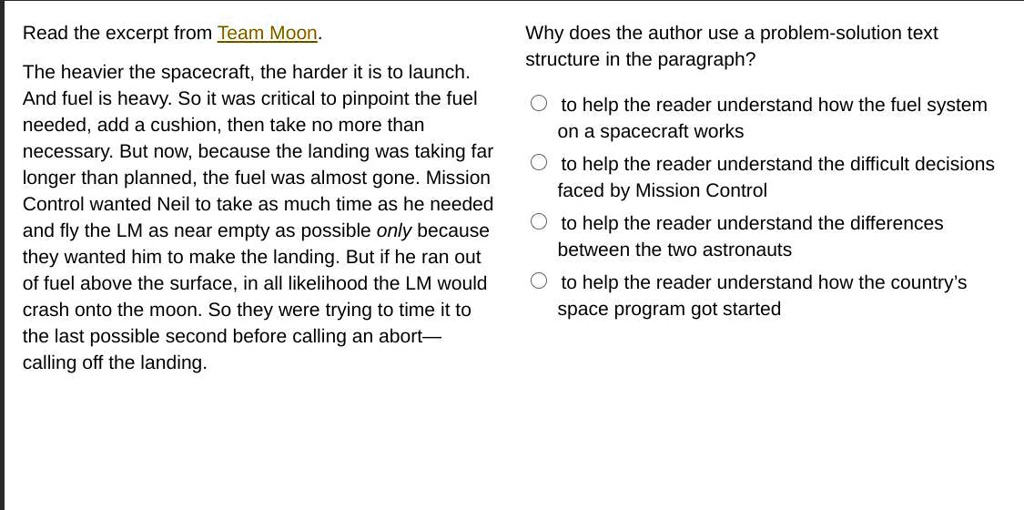When it comes to space travel, the weight of a spacecraft plays a critical role in its design, functionality, and overall mission success. The quote, "read the excerpt from Team Moon. the heavier the spacecraft, the harder it," emphasizes the significant challenges that engineers and scientists face when launching missions into the cosmos. This insightful excerpt sheds light on the complexities involved in space exploration and the delicate balance between innovation and practicality.
As humanity continues to push the boundaries of what is possible in space, understanding the implications of spacecraft weight becomes increasingly essential. The more massive the vehicle, the greater the force required to propel it beyond Earth's atmosphere, making every ounce of weight a crucial consideration during the design phase. This article will delve into the intricacies of spacecraft weight, the engineering challenges it presents, and how the insights from Team Moon can guide future missions.
In this exploration, we will examine the various factors that contribute to spacecraft weight, the innovative strategies employed to mitigate these challenges, and the potential implications for future space missions. To truly grasp the significance of the statement, "read the excerpt from Team Moon. the heavier the spacecraft, the harder it," one must appreciate the delicate interplay between technology, physics, and human ingenuity in the context of outer space.
What Are the Main Factors Contributing to Spacecraft Weight?
Spacecraft weight is influenced by a multitude of factors, each playing a pivotal role in the overall design and functionality of the vessel. Here are some of the primary contributors:
- Structural Materials: The choice of materials used in the spacecraft's construction directly impacts its weight. Engineers strive to find a balance between strength and lightweight properties.
- Fuel Requirements: The amount of fuel needed for the mission significantly contributes to overall weight, especially for long-duration spaceflights.
- Payload Capacity: The equipment and scientific instruments that a spacecraft carries add to its mass, necessitating careful planning to optimize performance.
- Life Support Systems: For crewed missions, life support systems are essential, but they also add considerable weight, requiring innovative solutions.
How Does Weight Affect Launch and Trajectory?
The weight of a spacecraft has profound implications for its launch and trajectory. Heavier spacecraft require more powerful rockets and more fuel, which can lead to increased costs and complexity during missions. Additionally, a heavier vehicle may affect the trajectory, necessitating precise calculations to ensure a successful journey. Key points to consider include:
What Are Some Innovative Solutions to Manage Spacecraft Weight?
To overcome the challenges posed by spacecraft weight, engineers and scientists have developed various innovative strategies, including:
- Use of Lightweight Materials: Advanced composite materials and alloys are increasingly being utilized to reduce weight without compromising strength.
- Optimized Design Techniques: Employing computer-aided design (CAD) tools allows for the creation of efficient structures that minimize unnecessary mass.
- Modular Design Approaches: Designing spacecraft in modular components can facilitate easier upgrades and repairs without adding significant weight.
- Advanced Propulsion Systems: New propulsion technologies, such as ion thrusters, can provide efficient thrust while reducing the overall weight of fuel required.
Can We Learn from Historical Missions Regarding Weight Management?
Historical space missions offer valuable lessons in weight management and engineering challenges. For instance, NASA's Apollo program faced significant weight challenges, leading to innovative engineering solutions. By examining past missions, we can glean insights that may benefit future endeavors. Notable examples include:
- The Apollo Lunar Module was designed with a focus on reducing weight while maintaining functionality.
- The Space Shuttle's design incorporated removable components to streamline weight during launch.
- Lessons from the Mars Rovers highlight the importance of balancing weight with scientific capabilities.
What Role Does Team Moon Play in Understanding Spacecraft Weights?
Team Moon, comprised of experts in aerospace engineering, astrophysics, and related fields, has contributed significantly to our understanding of spacecraft weights and the challenges they present. Their research and findings underscore the importance of addressing weight issues in the design and execution of successful space missions. They emphasize the following key points:
- Interdisciplinary collaboration is essential for developing effective solutions.
- Ongoing research is necessary to push the boundaries of current technologies.
- Innovation stems from understanding the historical context of spacecraft design.
How Will Future Missions Address the Weight Challenge?
As we look to the future of space exploration, addressing the weight of spacecraft will remain a critical focus. Upcoming missions to the Moon, Mars, and beyond will require innovative solutions that build upon the lessons learned from previous endeavors. Potential strategies include:
What Can We Expect from Future Spacecraft Designs?
Future spacecraft designs will likely reflect a deeper understanding of the balance between weight and functionality. Innovations in materials science, propulsion systems, and design methodologies will pave the way for more efficient and capable vehicles. Key advancements may include:
- Integration of smart materials that can adapt to environmental conditions.
- Enhanced AI-driven systems for optimizing weight distribution and performance.
- Greater emphasis on sustainable and reusable spacecraft components.
Conclusion: The Importance of Weight in Space Exploration
In conclusion, "read the excerpt from Team Moon. the heavier the spacecraft, the harder it" encapsulates a fundamental truth about space exploration. The weight of a spacecraft influences nearly every aspect of its design, from launch to mission execution. By learning from the past and embracing innovative solutions, we can continue to push the boundaries of what is achievable in space. As humanity looks to the stars, understanding and managing spacecraft weight will be paramount to our success in exploring the final frontier.



ncG1vNJzZmixn6PAtr7IZqWeq6RjsLC5jq2pnqaUnruogY6rnJqcXam1pnnEsZqeqqCpeqe%2BzqZkrZ2Ronquu86nZK2glWK1pq3VopyrZaSdsm6%2Fz5qanpuilrO1edOhnGagkaexpr6MoqtnoKSiuQ%3D%3D